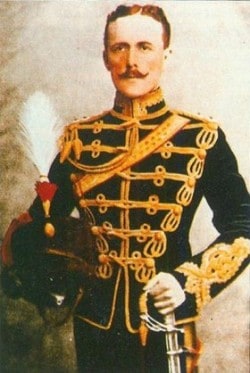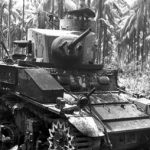FULL DRESS TUNICS
By 1881 the British hussar tunic was approaching its final form. Inspired by the German and Austrian Attila, the garment introduced in 1856 was long skirted and bore six loops of frogging across the front (Light dragoons had the same tunic but with five loops).
In 1874 the skirts were shortened to nine inches, in line with all other cavalry regiments. Each of the thirteen hussar regiments that existed at the beginning of Queen Victoria’s wore essentially the same uniforms except for minor, but important details.
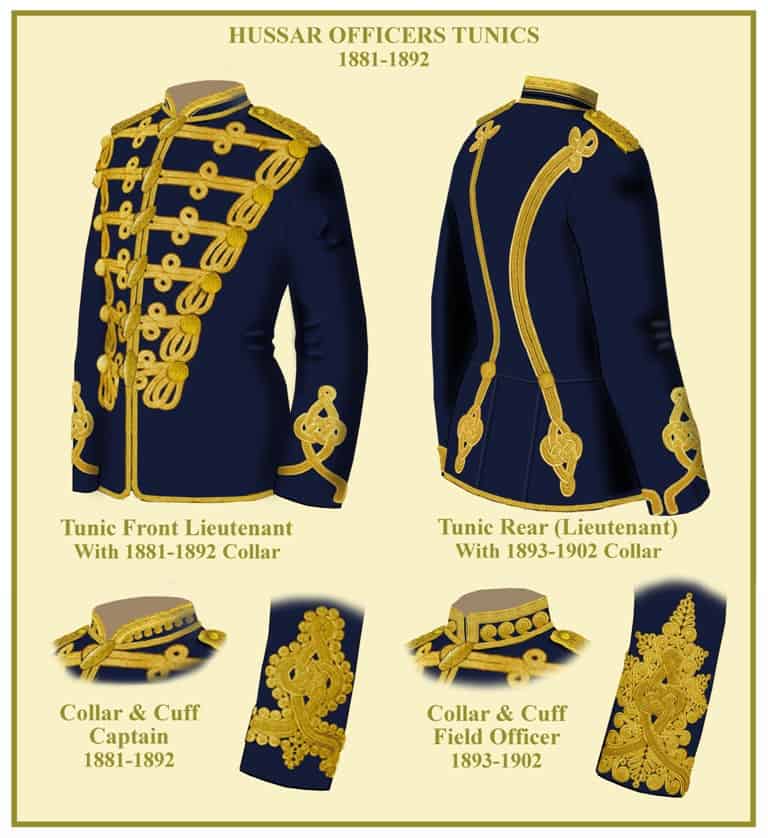
The 1883 regulations state that the tunic was of blue cloth, edged all round including the bottom of the collar with gold chain gimp. Across the breast were six loops of the same gold lace with caps and drops on each side and fastening with gold worked olivets.
On the back seams a double line of lace forming a crow’s foot at each shoulder and an Austrian knot at the bottom of the skirt. The lace was traced all round with a thin line of lace.
A netted cap upon the lace on each side of the waist. The shoulder-straps were of plaited gold chain gimp lined with blue and bore the rank badges in silver.
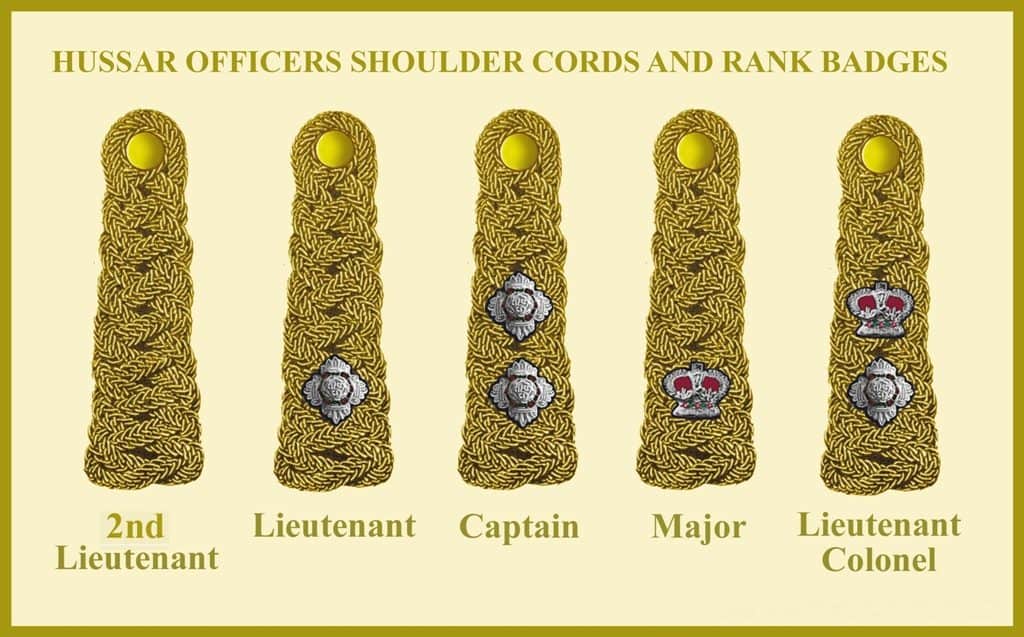
The cuffs were decorated as follows:
Lieutenants – A gold chain gimp Austrian knot reaching 8 inches from the cuff edge. A tracing of gold lace around the knot.
Captains – A row of braided eyes around the knot reaching 9 inches from the cuff edge.
Field Officers – Figured braiding around the knot reaching 11 inches from the cuff edge.
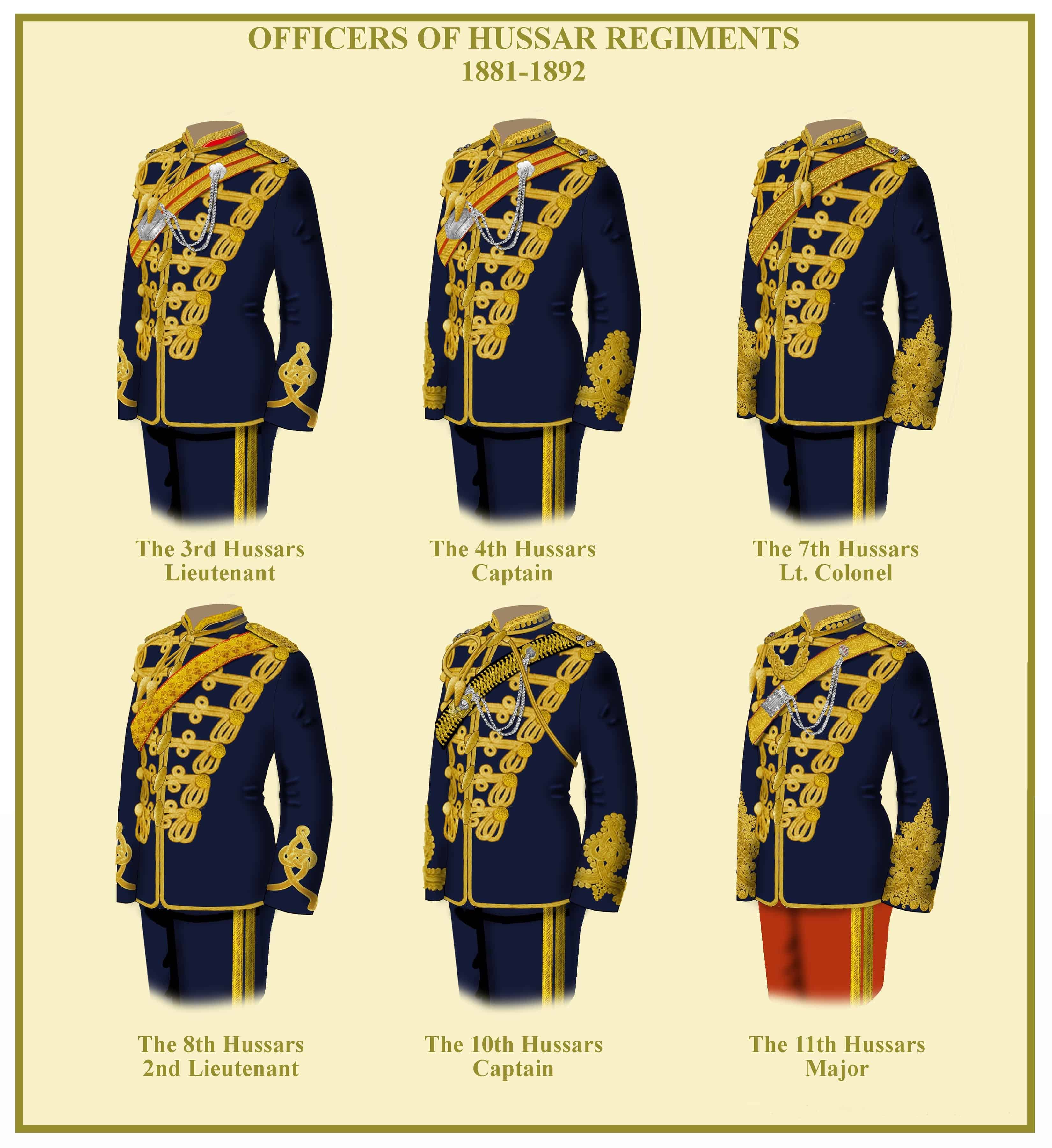
The illustrations show the tunics for the various regiments with their trousers/pantaloons. They also show how the busby lines were worn.
Most regiments show them looped around the neck and across the chest being hooked up on the right shoulder, the olivets hanging down to the top edge of the pouch belt.
The 10th hussars wore theirs around the body, under the arm and looping up to the top tunic olivet and then across to the shoulder.
The 11th Hussars had plaited lines from the neck to the shoulder as did the 21st Hussars from 1895 until they were converted to lancers.
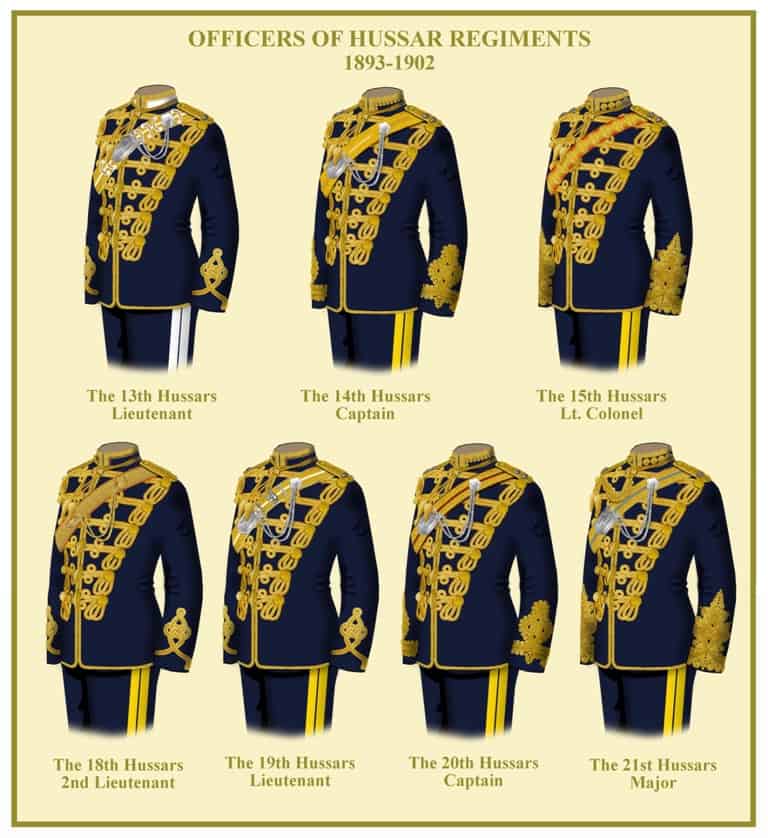
COLLARS
In general instructions for all cavalry, the collar was to be rounded in front and not to exceed 2 inches. There was a ¾ inch edging of regimental lace around the top and front of the collar. They were decorated as follows.
Lieutenants – A tracing of gold lace beneath the lace
Captains – A row of braided eyes beneath the lace
Field Officers – Figured braiding beneath the lace. (Essentially larger eyes)
In the 3rd Hussars the collar was of scarlet cloth and the 13th Hussars of white cloth (described as ‘buff’ in the regulations)
The 1891 regulations showed no changes whatsoever to the tunic descriptions. In 1893 the collars were ordered to be square, but continued to be 2 inches high and remained the same in the 1900 edition.
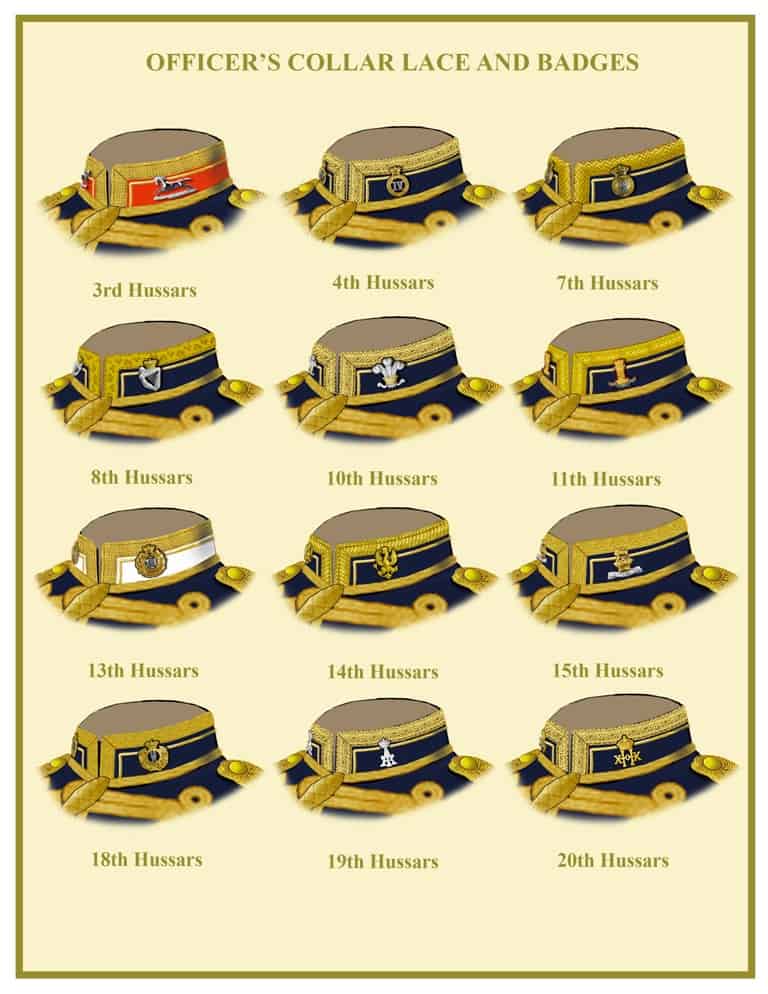
COLLAR BADGES
Like their colleagues in the heavy cavalry, collar badges began to appear on hussar collars in the late 1890s. These were generally authorised by the Horse Guards after requests by commanding officers.
The 10th Hussars were wearing them on undress frocks in 1898. Collar badges for all regiments were described in the 1900 regulations and they were as follows:
3rd Hussars The White Horse of Hanover in silver
4th Hussars “Queen’s Own Hussars” on a gilt circle with crown above. IV in silver within
7th Hussars “7th Queen’s Own Hussars” on a gilt circle with crown above. “Q O” intertwined in silver within the circle
8th Hussars The Harp in silver a with a gilt crown above
10th Hussars The Prince of Wales’s Plume in silver with gilt crown
11th Hussars The Prince Consort’s crest in gold embroidery on a crimson backing. Motto in gold lace on blue ground.
13th Hussars Gilt circle surrounded by laurel leaves with crown above. “Viret in certanum” on the circle. “HUSSARS” on a tablet below. “XIII” in silver in circle.
14th Hussars The Prussian Eagle in gilt or gilding metal
15th Hussars The Royal Crown in gilt with scroll below inscribed “Merebimur”
18th Hussars Gilt circle surrounded by laurel leaves with crown above. “Pro Patria Conamur” on the circle. On scrolls “WATERLOO” on the right and “PENINSULA” on the left. Within the circle, “18 over H in silver.
19th Hussars The Dagmar Cross over Princess Alexandria’s crowned monogram
20th Hussars xHx in gilt surmounted by an Imperial crown also in gilt
21st Hussars No badge ever authorised, Became Lancers in 1897
BUTTONS
For perhaps obvious reasons, hussars had never been authorised to wear regimental buttons prior to 1900. The only buttons on the tunic were on the shoulder straps and the buttons were described as “small domed gilt”.
Even when the undress buttoned jackets were introduced, the buttons continued to be plain domed. There is little direct evidence, but one suspects that regimental buttons on frocks had been used somewhat earlier than they were authorised in 1902.
PANTALOONS, TROUSERS & FOOTWEAR
Knee boots for mounted duties were the same as for other cavalry, except that there was a “V” cut notch at the top where a removable gold lace boss (similar to the one on the busbies) was attached on a slider.
Steel swan-necked spurs were worn. As with other cavalry, Wellington boots and heel-spurs were worn with trousers.
The Pantaloons and trousers for hussars were of blue cloth except for the 11th Hussars who had crimson cloth. Since 1864, double gold lace stripes ¾ inches wide and ¼ inch apart were worn down the outside seams of pantaloons and trousers (later overalls).
Double yellow stripes (buff [white] for the 13th Hussars) were worn on the pantaloons on active service and field exercises.
In 1893 the gold lace stripes on both pantaloons and trousers was discontinued and replaced by cloth. Although gold lace stripes remained on the trousers of dragoon guards, dragoons and lancers for levee dress, hussars had their own special pantaloons for levees (see below).
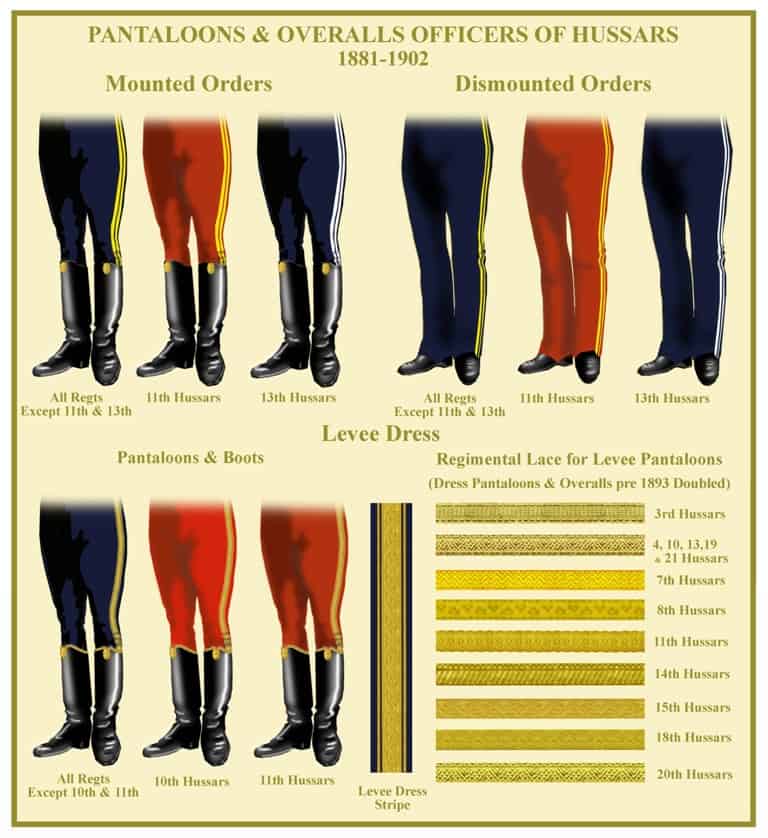
LEVEE DRESS
Fine cloth dark blue breeches were worn for all regiments except the 10th Hussars whose breeches were of scarlet Berlin diagonal cloth and the 11th Hussars which were of crimson cloth.
A single stripe of regimental lace was worn on the side seams with a tracing of gold Russia braid on each side. The fit of the Levee breeches was much tighter than the pantaloons for mounted duties.
With these breeches were worn Hessian boots of softer black leather and shorter with a gold lace edging round the top of the boot and the removable boss on the front. Straight necked steel spurs were worn.

